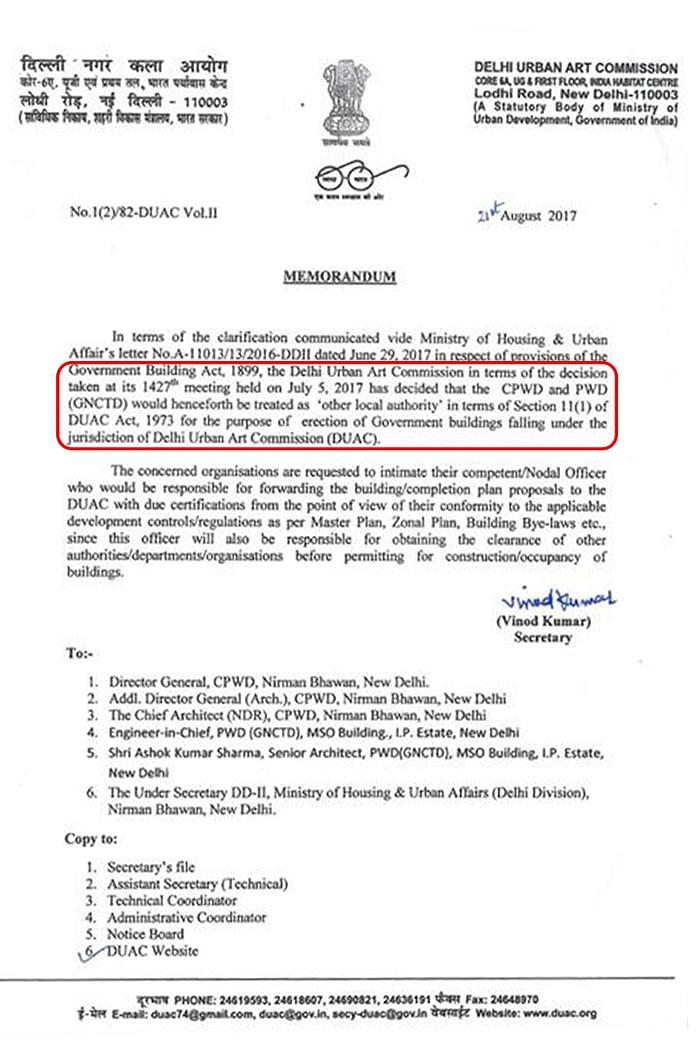For Central Vista, Govt Violates Law with Impunity
THE Central Vista Redevelopment Project (CV) in Delhi, right since its inception, has been in the news for its opaqueness and many mysteries that kept on developing as the massive project advanced. The strong push from the government of India, especially by the Prime Minister himself, for timely completion of the new Parliament building before his second term expires, has seen complete impunity from the laws of the land; here it means the building laws as determined by the Delhi Master Plan (MPD). These laws were violated by not following the due procedures and were trampled on by the government diktat.
The near Rs 20,000 crore project of the redevelopment of the CV will witness the construction of a triangular shaped new Parliament building, new residences of the PM and the vice president, new central secretariat buildings, demolition of the existing buildings along the Rajpath etc. The buildings that stand to be demolished include those which are just 40 years old and some of them, like the Jawahar Bhavan, which house the ministry of external affairs and is considered as a state of the art architecture built at a cost of Rs 220 crore and commissioned in 2011, will also be razed. The other buildings that will be demolished include: Indira Gandhi National Centre for the Arts, Janpath; Shastri Bhawan; Vigyan Bhawan; Krishi Bhawan; Vice President’s Residence; National Museum; Nirman Bhawan; Udyog Bhawan; Raksha Bhawan; Annexe Building of National Archives; 7, Race Course Road (the prime minister’s current residence). A total of 4,58,820 square metres of the total built area will be demolished for the project.
NEW VOICES AND OPPOSITION TO CV
Since the inception of the CV project, it invited a lot of controversy over the way and the manner in which it was dealt with. There were issues raised regarding heritage, the need for such a wasteful expenditure when already a functioning Parliament building is running, along with the violation of building by-laws, loss of green cover, fudging the environment impact assessment (EIA), cutting down of trees, surrendering of open public spaces to the government. Issues such as complete opaqueness in the bidding process allowing the QCBS system, which is considered appropriate only for bidding tenders for works and cannot be seen as a prudent way of considering a design for the Parliament building, and not allowing a fair play of creativity to explore in the ideas of the new parliament, were also quite pertinent. The most vocal and vociferous critics were saying that there has been a complete violation of the procedures in granting this project from the land-use change to preserving heritage.
Several petitions were filed in the court and eventually, the Supreme Court gave a green signal with a division verdict of 2:1 stating that the CV redevelopment project should go ahead as the government of India desires. However, the dissenting judge categorically stated that the project is illegal in the eyes of law.
As the work started to advance and the pandemic struck the country, voices were raised from vast sections of the people that this government led by the PM Modi is pushing for a vanity project and spending people’s money, and the same should have been appropriately utilised for meeting the health crisis and mitigating the pandemic. People were dying because of the want of oxygen, lack of beds in hospitals, and the government system just crumbled. Gory stories and scenes of bodies floating in the rivers, especially the Ganges, were heart-rending.
In such a situation, the government termed the CV project as a national essential project. When there was lockdown in major parts of the country, including Delhi, the project work continued incessantly. Voices were raised by different sets of people arguing that at least during the pandemic, peoples’ (workers at the site) lives should be spared and this project should be halted during the lockdown period. A petition was filed in the Delhi High Court, which gave a ruling against the petitioners and allowed work at the site.
But this is not all! The government, despite claiming all success through its legal entanglements, is not happy. Several sections of the media have also highlighted the unfairness of this project especially during the pandemic and the government issued two statements--the first one was by the ministry of housing and urban affairs to a write up in one of the web portals terming this project as sheer waste of money; and the other was by the minister of the same ministry himself against a statement of bureaucrats who had asked the government to withdraw this project. The minister not only defended the project but also said that those who signed this letter were ‘padde likhe gawar’ (educated illiterate) and a ‘disgrace to the nation’. This also explains the desperation with which this government is going ahead with this project.
NEW REVELATIONS
But there is more to all this. The new revelation in both the ministry’s response to the web portal and the minister’s statement has a lot to show.
Why there is desperation in the government was explained by Romi Khosla, a well-known architect that this country has produced, whilst interacting with this writer. According to Khosla, the driving force of this government is sheer ideological obscurantism. They have been made to understand by some ‘Vaastu’ style architects that unless they (the present BJP government) shifts from the round-shaped Parliament, which is considered bad for them, they will not be able to retain power at the Centre in the 2024 elections. Hence, the deadline for the Parliament building to finish off on time is of utmost importance, he said. Another article written in these columns discussed the genesis of this argument developed in a dialogue between the then Speaker of the Lok Sabha, Manohar Joshi, and these group of Vaastu architects.
The second important issue that needs to be framed here before going into the concrete revelations is that the Modi government inherits the legacy of German leader, Hitler. Like him, Modi decimates the modernism of Nehru and his buildings, his presence, and the relation of the people vis-a-vis government. The open spaces around the Rajpath were important for the people to assemble not just to picnic but also to have a feel of governance. This was pointed out by artist Vivan Sudaraman and architect Prem Chandavarkar. This relation of the people with the government must change and make way for a ‘ruler-ruled’ relationship. The new buildings of the central secretariat that are being planned are to showcase the sheer strength of the government and the inaccessibility of the people to them; to tell the people that the government is all-powerful and that they must adhere to the diktats!
NEW ISSUES HAVE EMERGED
Massive public space being usurped: According to the EIA (Environment Impact Assessment) submission, which was not there in the beginning, land-use change is proposed at six places--from public and semi-public facilities to government offices. The Parliament building is coming up at a designated district park. Nearly 120 acres of public land ranging from 3.9 acres of space to 24.7 acres is being usurped for the government buildings and encroaching upon the public open spaces. This change in land use is completely illegal as the Delhi Master Plan, which designates these areas as heritage, or open spaces or designated parks, cannot be usurped by a government diktat by violating the procedure laid down under the law. There were objections raised right since the inception of the project to the procedure being scuttled. For example, objections were raised to public hearing, and to the way the designs were approved. However, the government did not pay any heed to the objections and went ahead with the proposal.
CPWD becomes a local body: The building plan approval has to be done by a local body. This is the universal law prevailing in the country. The local bodies in the cities are assigned this task. In the CV redevelopment project, the different spaces, lies under the NDMC (New Delhi Municipal Council), which is not elected but has 13 members some of whom are elected legislators, and a few more are nominated by the Delhi chief minister; rest are officials or bureaucrats. In this case, it is the NDMC that should have approved these plans. But in sheer hurry and desperation, the government of India has converted the CPWD as a local body.

CPWD, which is a developer and a construction arm of the government is self-sanctioning the redevelopment project in the present case. Even the DUAC (Delhi Urban Arts Commission), which approved the drawings, is not authorised to give such permission. Hence, all of this is illegal.
TOD project: This is something very recent. A Transit Oriented Development (TOD) project is one which should have 30% of its total area as residential. It should have reduced parking and more to do with mobility through the Metro. It is one of the forms of capitalist developmental models where people live near the Metro and do not use their cars, and instead, use public transport for their mobility.
Interestingly, the government of India in its affidavit specifically mentioned in the Supreme Court that the CV project is not a TOD project, because then it will mean many things. For example, is housing also coming along the Rajpath in the CV precinct, etc.? But as the principal architect of the CV project has been saying that it is an evolving project, the Union ministry of housing in a reply to the web portal said that the CV is a TOD, and is part of the guiding principles of this project.
The MPD 41 for Delhi does not apply on the Central Vista redevelopment project and hence, the TOD should not be applicable in the project. However, it is not yet clear from the reply of the ministry whether TOD is one of the guiding principles of Modi’s mind, ‘to find an opportunity in every crisis’ -- and will we have some private sell out of the CV area to corporates? The government has to tell us more about it. As of now we are not sure of it.
Huge space for ministers and bureaucrats: As stated above, nearly 4.5 lakh square metre area will be demolished for CV but nearly 16.5 lakh square metre area will be constructed. This brings in to a per capita availability of nearly 195 square feet of built-in space. Nearly 85% of the workforce in the secretariat is Group III and IV who occupy less than 60 square feet per person. The ministers will be holding more than 3,000 square feet per person which is larger than the size of a four-bedroom flat. Then the proposal is to have yoga and music rooms for these bureaucrats. Nearly 260 conference rooms are proposed to be constructed for holding meetings with a capacity of 50 each. Whereas the government has been proposing minimum government and maximum governance, this is the reality that we are witnessing.
Playing with the FAR: Floor area ratio (FAR) determines the space that a certain building or project will get. Here the FAR has been raised from 120 to 200, and one of the reasons for terming it as a TOD is also that in the guise of a TOD, the project can get a higher FAR. This means more space for the buildings and parking, which goes against the principles of TOD.
Cutting down trees: It is quite ironic that for the first time instead of the developer saying that a certain number of trees have to be cut down or transplanted to some other site, here the developer i.e., the CPWD has asked the beneficiary of the contract to ascertain as to how many trees will be transplanted. According to the EIA and EMP reports, there are 3,750 trees that are either to be cut down or transported to some other location. So, it is a loss of both open and green spaces.
The CV project that started with a completely subjective mind undermining the relevance of building laws, environment, heritage, and architecture, continues to be mired in controversy. As it evolves, as the constructing architect said, we are bound to have many more surprises. But the tragedy is that the government, legislator, and executor of law is violating the law itself, with impunity.
The writer is former Deputy Mayor of Shimla, Himachal Pradesh. The views are personal.
Get the latest reports & analysis with people's perspective on Protests, movements & deep analytical videos, discussions of the current affairs in your Telegram app. Subscribe to NewsClick's Telegram channel & get Real-Time updates on stories, as they get published on our website.
























